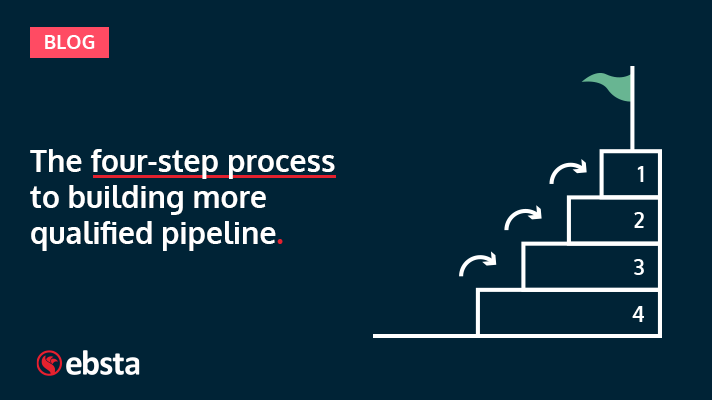Share this article
Learn from the brightest minds how to predictably and efficiently grow revenue.
Related Content
5 Ways to Use the Ebsta Integration With HubSpot to Improve Sales Performance
How to improve adoption of HubSpot with Ebsta
B2B Sales Benchmarks: 2023 H1 Update
The latest update from the 2023 B2B Sales Benchmarks analysis of over $37bn in pipeline.
How to improve AE quota attainment (according to data)
23% of reps are contributing 83% of revenue. Here's how to solve it (with data)

The four-step process to building more qualified pipeline
Build qualified pipeline with these 4 easy to implement steps:
- Finding your dream prospect
- The titles you should be going after
- Prioritizing your pipeline
- Building relationships
Step 1 – Who is your dream prospect?
Did you know more than 40% of salespeople say prospecting is the most challenging part of the sales process, followed by closing (36%) and qualifying (22%)?
Make prospecting easy with this trick:
Build an ICP!
An ideal customer profile is a fictitious description of businesses that will experience the most value from your product or solution.
Why should I build an ICP?
It equips you with the information you need to sell to them with more of a personal touch.
This information includes information on their industry, budget, customer base, etc.
You will save time and resources as you are targeting leads who have a genuine need for your product or service.
How?
By identifying the characteristics of customers which you have already successfully closed.
Build your ICP today in 4 easy steps to make prospecting the least challenging part of your sales process.
Step 2 – What titles are you going after?
Now you’ve outlined the types of business you want to target, who specifically should you reach out to?
High-performing companies prioritize engagement with key personas.
These key personas can be found in two parts of the MEDDPICC® framework:
- Economic Buyer
- Champion
Targeting these key personas sets apart high-performing companies from low-performing ones.
High-performing companies take a more targeted approach when it comes to building relationships by increasing engagement with key decision-makers.
They target the economic buyers, champions, and other stakeholders who provide high value.
In fact, we found that the average engagement for high-performing companies was 41% compared to an average of 24% for low-performing companies.
In this case study, engagement was measured as a number between 0 and 100 that represents engagement.
This considers total activity count and days since last activity, but it also looks at the type of activity, its direction (inbound, outbound), duration, and timing to derive a single engagement percentage metric.
Key personas
The economic buyer has the final say in the business decision and can be identified by hitting the following criteria:
- Are they the person signing your contract?
- Do they have veto power?
- Is their main focus on the strategy and objectives of their business?
- Do they have access to discretionary funds not allocated in the budget?
A champion is someone who has a vested interest in the success of your product.
They act as an internal seller on your behalf.
Instead of getting information from here, there, and everywhere, your champion can save you a lot of time and provide you with all the information you could possibly need.
The economic buyer and champions usually have the same titles across companies. By identifying the economic buyers and champions in deals you have successfully closed, you are onto a winning strategy.
Step 3 – Prioritize, prioritize, prioritize!
At this stage, you should have a list of businesses that fit your ICP.
Now, you’ve got to sort through these and prioritize them. How?
By how closely they fit your ICP.
For example, if you have 10 characteristics that you have found common across all your closed-won deals then you want to prioritize the leads who also fit these 10 characteristics first.
Are your top-performing accounts in the same location, the same industry, the same type of company, etc.
The most desirable characteristics will naturally form your top 10.
After this, it is just a process of elimination. Next are the companies who fit 9, then 8, and so on and so forth.
By doing this you are optimizing your sales pipeline by targeting the most qualified leads first.
Step 4 – Building the RIGHT relationships with the RIGHT people
Salespeople are not talking to companies, they are talking to people.
So you want to ensure they are building strong relationships with the right people. Why?
The more key relationships you build, the more likely you are to succeed and deliver shorter sales cycles.
In step 2, we saw the power of building the right relationships through the case study.
Decision-makers define the success of the deal.
At the end of the day, the final decision is made by a few key stakeholders and if your sales teams are not highly engaged with these stakeholders, this reduces the chance of closing deals successfully.
How do I do this?
Building relationships is more than small talk.
It is gaining the trust of your stakeholders.
This takes time and consistency.
Understand the needs and desires of your stakeholders.
What are their biggest pain points and how do you directly solve them?
Once you nail these questions, building relationships should be a piece of cake.
Conclusion
Introducing these 4 quick wins will result in more qualified leads who are primed and ready for your product or service.
Salespeople can sell to everyone under the sun but not everyone will buy or have a need for your product or solution.
Separate the winners from the losers, optimize your sales pipeline and improve your win rates today with these 4 easy steps.
Where do you go from here?
You’ve hopefully learned how to build pipeline but now you want to push these deals through your pipeline to a close.
Accelerate your deals through your pipeline and win them now.
